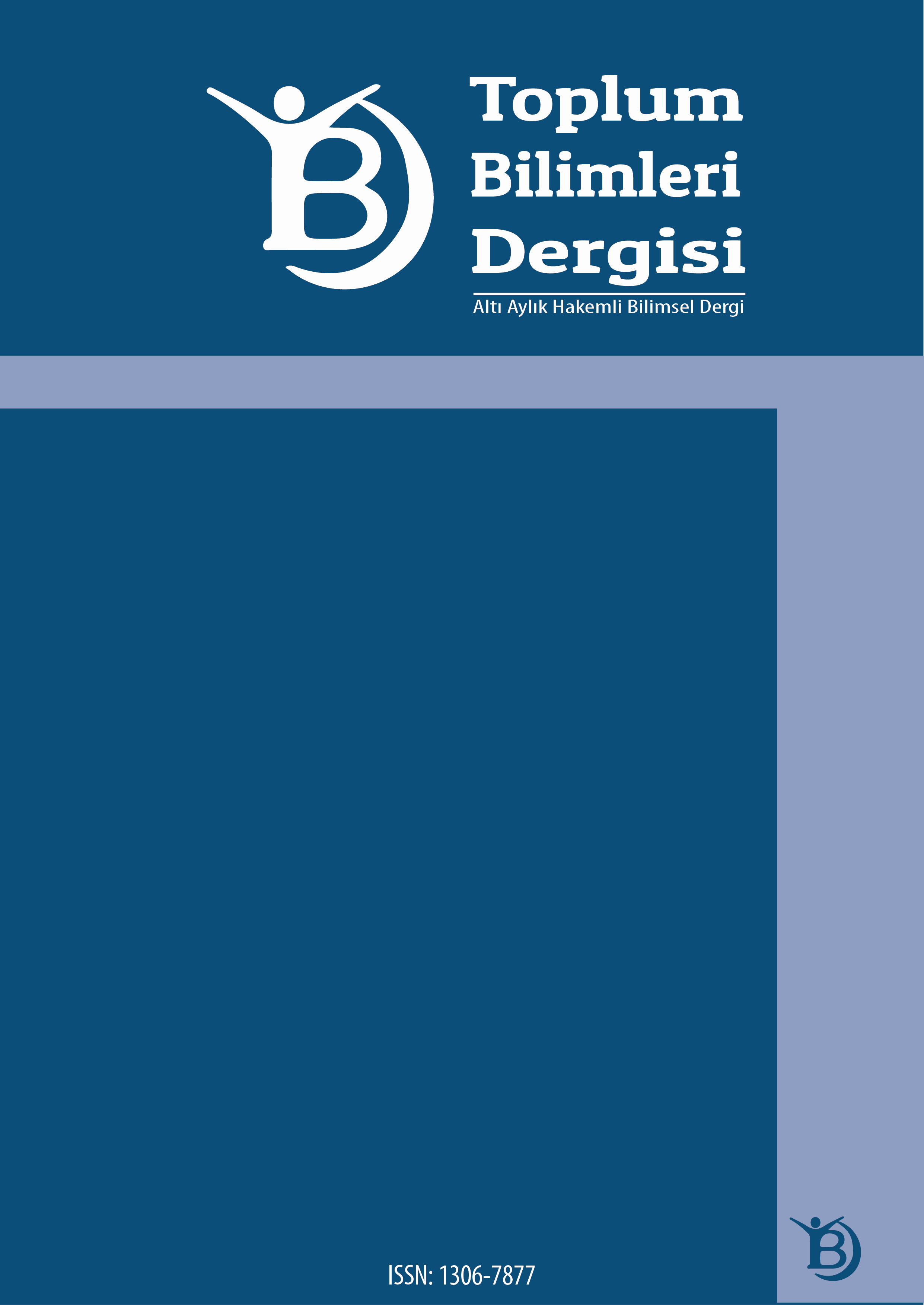Author :
Abstract
Bu araştırma da çocukların zihinlerinde oluşturdukları Tanrı imgelerini daha iyi anlamak amacıyla iki aşamalı bir çalışma yapıldı. İlk aşamada çocuklara “Allah denildiğinde ne düşündükleri” soruldu ve verdikleri cevaplar kendi içinde iliş- kili olduğu düşünülen üç bölüme ayrılarak frekansları doğrultusunda sıralandı. İkinci aşamada çocuklardan alınan cevaplar ve alanyazın taranarak bir ölçek oluşturuldu. Araştırmalar dikkate alınarak ölçek maddeleri gözden geçirilmiş ve uzmanlara gönderilmiştir. Ölçek formu 58 adet algı ifadesiyle oluşturulmuş uzman görüşlerinden sonra 50 maddeyle uygulanmaya hazır hale gelmiştir. Araştırma için seçilen 600 kişilik gruba 50 maddeden oluşan ön deneme formu uygulanmıştır. Ölçeğe ilişkin kuramsal yapı dikkate alınarak açımlayıcı faktör analizi yapılmıştır. Buna göre elde edilen 24 maddelik ve 4 alt boyuta sahip tanrı imgesi ölçeğinin geçerliği belirlenmiştir. Ölçeğin güvenirliğini belirlemek için madde toplam test korelâsyonu hesaplanmış ve ölçeği oluşturan maddelere ilişkin Cronbach alfa (crα) değeri 0,73 olarak bulunmuştur. Ayrıca 20 kişilik farklı bir grupta iki farklı zamanda ölçek uygulanmış ve test tekrar test güvenirliğine ilişkin bulgular elde edilmiştir. Doğrulayıcı faktör analizi için örneklem grubunun özelliklerine benzer olarak farklı bir gruptaki 398 öğrenci seçilmiştir. Doğrulayıcı faktör analizinde güvenirlik çalışması 398 katılımcının, ölçeğin 28 maddesine verdikleri yanıtlardan elde edilen iç tutarlık katsayısı 0.78 olarak belirlenmiştir
Keywords
Abstract
The goal of this two-staged study was to beter understand how children conceive of God. In the frst stage of this study children were asked, “what comes to mind when you hear the word God’?” Their answers to this queston were organized according to frequency and classifed into three separate groups according to the nature of the response. In the second stage of this study a questonnaire was developed by surveying the literature in the feld in connecton to the responses obtained from the children. The original questonnaire of 58 items was then reviewed on the basis of other research in the feld and sent to experts for comment. The fnal questonnaire used in this study was reduced to 50 items and was prepared for implementaton. This questonnaire was then given to a group of 600 people selected for this study. The results of this preliminary test were then subjected to an exploratory factor analysis with atenton to the theoretcal structure of the questonnaire. On the basis of these results, the questonnaire was reduced to 28 items with four sub-scales, and its validity was determined. In order to determine the reliability of the questonnaire, the internal correlaton of its items was calculated, with a Cronbach alpha (crα) value of 0.73. Additonally, the questonnaire was implemented in a different 20-person group on two separate occasions and fndings showing the test re-test reliability of the questonnaire were obtained. For the confrmatory factor analysis, a separate group of 398 students, of similar characteristcs to the sample group was selected. As part of the 398 partcipant reliability study of the confrmatory factor analysis, the internal consistency coefcient for responses obtained for Item 28 was 0.78.
Keywords
- x2 p>.05 Kline (1998), Sümer (2000), Tabachinck and Fidel (2007), Hair, etc..(2006)
- Beilin, H. (1992). “Piaget’s Enduring Contribution to Developmental Psychology”, Developmental Psychology, Vol.28 (2), 191-204.
- Burman, J. T. (2008). “Experimenting in Relation to Piaget: Educationis a Chaperoned Process Adaptation”, Perspectives on Science, Vol. 16 (2), 160-195.
- Coles, R. (1990). TheSpiritual Life of Children, Boston: Houghton Mifflin Company.
- De Ross, S. A., Meidema, S., Iedema, J. (2001) “Attachment, Working Models of Self and Others, and God Concept in Kindergarten”, Journal for the Scientific Study of Religion, Vol.40, No.4, pp.607-618.
- Elkind, D.(1981). Children and Adolescents, Third Edition, Oxford: Oxford University Press.
- Fowler, J. M. (1995). Stages of Faith, San Francisco: Harper Collins Publisher.
- Graebner, O. E.(1964) “.Child Concepts of God”, Religious Education, Vol.59(3), 234-242.
- Güler, Ö. (2007). Tanrı’ ya Yönelik Atıflar, Benlik Algısı ve Günahkârlık Duygusu (Yetişkin Örneklem), Ankara Üniversitesi Sosyal Bilimler Enstitüsü Felsefe ve Din Bilimleri (Din Psikolojisi) Anabilim Dalı Basılmamış Yüksek Lisans Tezi, Ankara. Hair, J. F., Black, W. C., Babin, B.J. , Anderson, R. E. (2006) Multivariate Data Analysis, New Jersey: Prentice Hall.
- Heller, D.(1998). The Children’s God, Chicago: The University of Chicago Press.
- Hopkins, B. (2005). The Cambridge Encyclopedia of Child Development. Cambridge: Cambridge University Press.
- Kirkpatrick, L. A. (1992). “An Attachment-Theory Approach to The Psychology of Religion”, International Journal for The Psychology of Religion, Vol. 2, no. 1, pp. 3-28.
- Kline, R. B. (1998). Principles and Practice of Structural Equation Modeling, New York: The Guilford Press.
- Kuşat, A. (2006). “Ergenlerde Allah Tasavvuru”, Dindarlığın Sosyo-Psikolojisi, Adana: Karahan Kitabevi yay.
- Lawrence, R.T.(1997). “Measuring The Image of God: The God Image Inventory and The God Image Scales”, Journal of Psychology and Theology,Vol. 25 (2), 214-226.
- Maiello, C. (2005) “Degrees of Belief In God: A Measure of Belief for Use In Cross Culture”, Mental Health, Religion&Culture, 8(2), 87–95.
- Mehmedoğlu, A. U. (2011) Tanrıyı Tasavvur Etmek, İstanbul: Çamlıca Yayınları.
- Munari, A.(2000). Jean Piaget, UNESCO: International Bureau of Education, Vol. XXIV, (1/2) , 311–327.
- Öcal, M.(2004). “Okulöncesi ve İlköğretim Çağı Çocuklarının Allah Tasavvurları Üzerine Bir Araştırma”, Uludağ Üniversitesi İlahiyat Fakültesi Dergisi, S.2 (13), 59-80.
- Ratcliff, D. (2008). A Century of Children’s Spirituality Research, Price-Le Bar Inaugural Lecture, Wheaton College, February-6.
- Schultz, D.P., Schultz, S.E.(2007). Modern Psikoloji Tarihi, Yasemin Aslay (Trs), İstanbul: Kaknüs
- Stratton, P., Hayes, N. (1996). A Student’s Dictionary of Psychology, London: Arnold.
- Streib, H. (2000). Gottesbilder fallennicht vom Himmel: Kindliche Malprozesseals Gestaltung von Religion. Religiöse Vorstellungenbilden: Erkundungenzur Religion von Kindernüber Bilder, Dietlind Fischer&Albrecht Schöll (Ed), Münster: Comenius-Inst.,123-135.
- Sümer, N. (2000). Yapısal Eşitlik Modelleri: Temel kavramlar ve örnek uygulamalar. Türk Psikoloji Yazıları, 3(6):74-79.
- Tabachnick,B. G., . Fidell, L. S.(2007). Using Multivariate Statistics, San Francisco: Harper Collins
- Tamminen, K.Vianello, R. Jaspard, J.M. Ratcliff, D. (1988), “Religious Concepts of Preschoolers”, Handbook of Preschool Religious Education, Donald Ratcliff (Ed).Birmingham & Alabama: Religious Education Press.
- Yıldız, M. (2007).Çocuklarda Tanrı Tasavvurunun Gelişimi, İzmir: İzmir İlahiyat Vakfı Yayınları.
